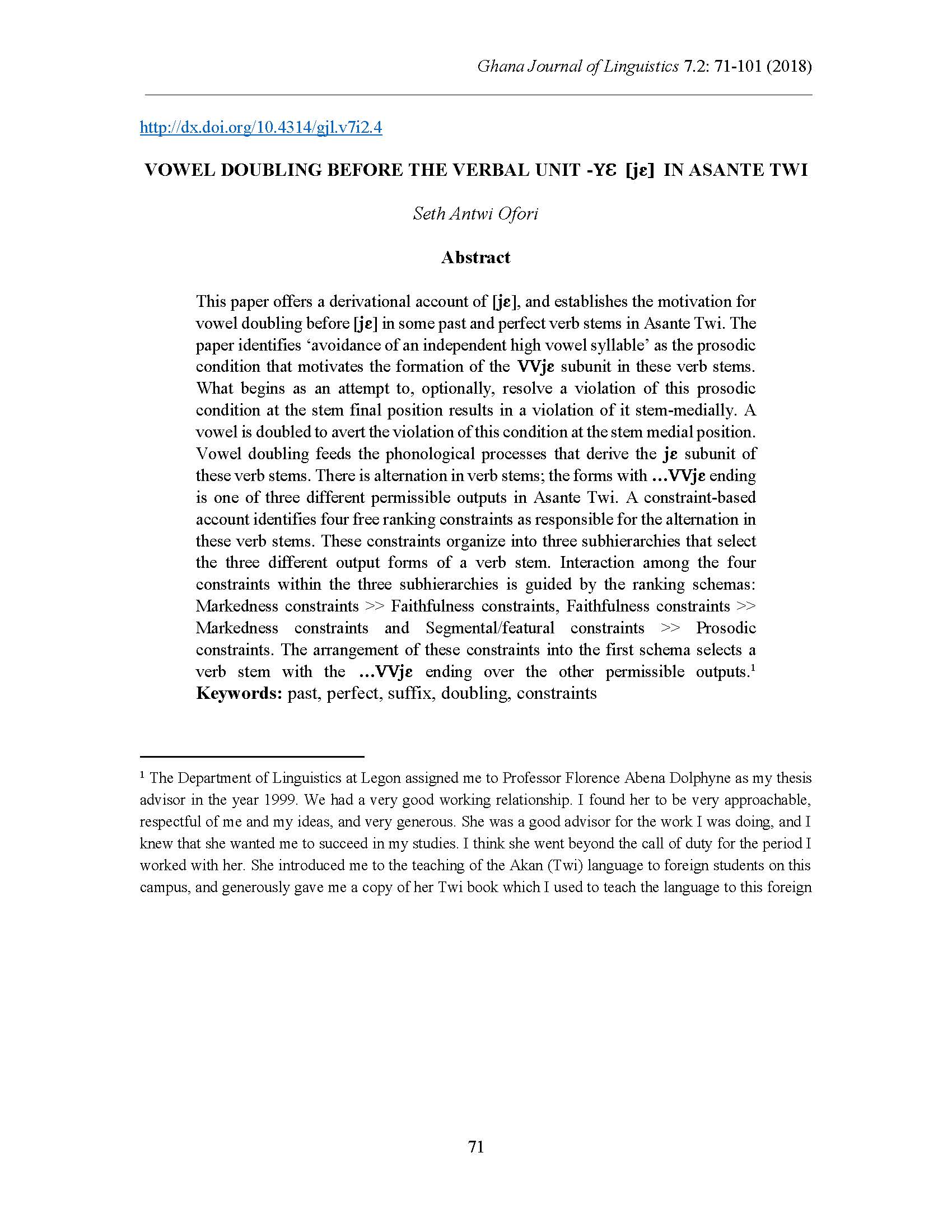Vowel Doubling Before The Verbal Unit -Yɛ [jɛ] In Asante Twi
DOI:
https://doi.org/10.4314/gjl.v7i2.226Keywords:
past, perfect, suffix, doubling, constraintsAbstract
This paper offers a derivational account of [jɛ], and establishes the motivation for vowel doubling before [jɛ] in some past and perfect verb stems in Asante Twi. The paper identifies ‘avoidance of an independent high vowel syllable’ as the prosodic condition that motivates the formation of the VVjɛ subunit in these verb stems. What begins as an attempt to, optionally, resolve a violation of this prosodic condition at the stem final position results in a violation of it stem-medially. A vowel is doubled to avert the violation of this condition at the stem medial position. Vowel doubling feeds the phonological processes that derive the jɛ subunit of these verb stems. There is alternation in verb stems; the forms with ...VVjɛ ending is one of three different permissible outputs in Asante Twi. A constraint-based account identifies four free ranking constraints as responsible for the alternation in these verb stems. These constraints organize into three subhierarchies that select the three different output forms of a verb stem. Interaction among the four constraints within the three subhierarchies is guided by the ranking schemas: Markedness constraints >> Faithfulness constraints, Faithfulness constraints >> Markedness constraints and Segmental/featural constraints >> Prosodic constraints. The arrangement of these constraints into the first schema selects a verb stem with the …VVjɛ ending over the other permissible outputs.[1] Keywords: past, perfect, suffix, doubling, constraints
[1] The Department of Linguistics at Legon assigned me to Professor Florence Abena Dolphyne as my thesis advisor in the year 1999. We had a very good working relationship. I found her to be very approachable, respectful of me and my ideas, and very generous. She was a good advisor for the work I was doing, and I knew that she wanted me to succeed in my studies. I think she went beyond the call of duty for the period I worked with her. She introduced me to the teaching of the Akan (Twi) language to foreign students on this campus, and generously gave me a copy of her Twi book which I used to teach the language to this foreign student. She was there for me, and I am very happy to be able to join with the rest of my colleagues in linguistics to honor her with this publication on her 80th birthday.
References
Clements, G. N. and Elizabeth V. Hume. 1995. “The internal organization of speech sounds.” In The handbook of phonological theory, edited by John Goldsmith, 245-
306. Oxford: Blackwell.
Dolphyne, Florence. 1988. The Akan (Twi-Fante) language: Its sound systems and tonal structure. Accra: Ghana Universities Press.
Fromkin, Victoria. 2000. Linguistics: An introduction to linguistic theory.
Malden, MA: Blackwell.
Goldsmith, John. 1976. Autosegmental Phonology. Doctoral dissertation, MIT.
Goldsmith, John. 1996. The handbook of phonological theory. Cambridge: Blackwell
Publishers.
Halle, Morris and Jean-Roger Vergnaud. 1982. “On the framework of autosegmental
phonology.” In The structure of phonological representations, edited by Harry van
der Hulst and Norval Smith, Vol.1: 65 – 82. Dordrecht: Foris.
Harris, John. 2007. “Representation.” In The Cambridge handbook of phonology, edited
by Paul de Lacy, 119 - 137. Cambridge: Cambridge University Press.
Hume, Elizabeth. 1992. Front vowels, coronal consonants and their interactions in non-linear phonology. Doctoral dissertation, Cornell University.
Kager, René. 1999. Optimality Theory. Cambridge: Cambridge University Press.
Kenstowicz, Michael. 1994. Phonology in generative grammar. Malden, MA: Blackwell.
Lahiri, Aditi and Vincent Evers. 1991. “Palatalization and coronality.” In The special status of coronals: internal and external evidence, edited by Carole Paradis and Jean-Francois Prunet, 79-100. Phonology and Phonetics 2. San Diego, CA: Academic Press.
McCarthy, John. 1988. “Quantitative transfer in reduplicative and templatic morphology.” In Linguistics in the morning calm 2, edited by Linguistic Society of Korea, 3-35. Seoul, Hanshin Publishing Company.
McCarthy, John. 2002. A Thematic Guide to Optimality Theory. Cambridge: Cambridge
University Press.
McCarthy, John. 2007. “Derivations and levels of representation.” In The Cambridge handbook of phonology, edited by Paul de Lacy, 99 - 117. Cambridge: Cambridge University Press.
Ofori, Seth A. 2006. Ma yɛnka Akan (Twi): A multidimensional approach to the teaching and learning of Akan (Twi) as a foreign language. Madison, Wisconsin: NALRC Press.
Osam, Kweku E. 2003. “An introduction to the verbal and multi-verbal system of Akan.”
In Proceedings of the workshop on Multi-Verb Constructions, edited by Dorothee Beermann and Lars Hellan. Trondheim Summer School 2003.
Sagey, Elizabeth. 1986. The representation of features and relations in nonlinear phonology. Doctoral Dissertation, MIT.
van der Hulst, Harry and Jeroen van de Weijer. 1996. “Vowel Harmony.” In The Handbook
of Phonological Theory, edited by John Goldsmith, 495-534. Cambridge, MA: Blackwell
Zec, Draga. 2007. “The syllable.” In The Cambridge handbook of phonology, edited by Cambridge Paul de Lacy, 159 - 194. Cambridge University Press.

Downloads
Published
How to Cite
Issue
Section
License
The Ghana Journal of Linguistics is published by the Linguistics Association of Ghana, P. O. Box LG 61, Legon, Accra, Ghana.
LAG Email: linguisticsgh@gmail.com. Website: http://www.laghana.org
GJL Email: gjl@laghana.org Website: http://www.laghana.org/gjl
© Linguistics Association of Ghana and individual authors, 2023.
